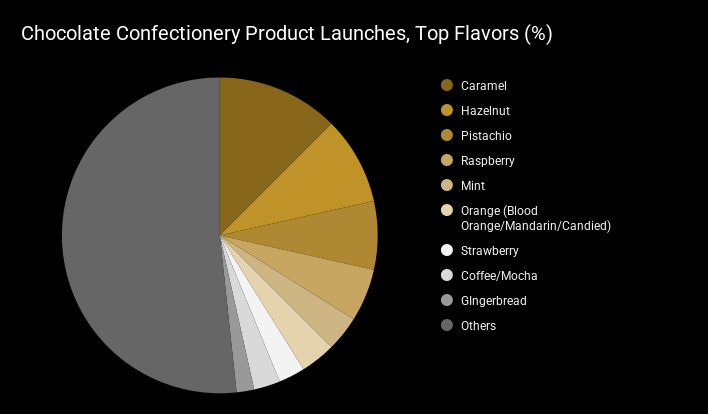Chocolate Confectionery Product Launches, United Kingdom, 2024: A Review Of Notable Flavors
The UK chocolate landscape continues to diversify, with classic favorites evolving and global influences enriching product development. Based on an analysis of product launches during the year, here are the most prominent flavor trends.
Caramel: The Reigning Champion Of Flavor Innovation
Caramel dominated the flavor space. Its versatility is reflected in formats ranging from salted and peach caramel to caramel latte infusions. Booja Booja’s Salted Caramel Chocolate Wonders, and Divine Chocolate’s Joyful Bar with sweet caramel and candied orange demonstrate caramel’s ability to bridge indulgence and mass appeal. Meanwhile, COCO Chocolatier’s Salt & Pepper Caramel highlights a shift toward savory-sweet hybrids.
Hazelnut: A Time-Tested Ingredient Gets A Gourmet Makeover
Hazelnut remains a core ingredient in the premium segment with brands continuing to innovate with hazelnut gianduja, praline, and roasted formats. Radek’s Hazelnut Gianduja Truffles, Läderach’s Chocolate Pearls Hazelnut, and Divine’s hazelnut-packed Joyful Bar are recent examples. Its role as a rich, nutty complement to both milk and dark chocolate keeps it firmly in consumer favor.
Pistachio: Riding On The Viral Dubai Chocolate Trend
Driven by the viral Dubai Chocolate trend, pistachio was a prominent flavor in the UK, often paired with white or milk chocolate. Noteworthy launches include Läderach’s Pistachio FrischSchoggi, Godiva’s Dubai-inspired pistachio bar, and Chox Chocolates’ pistachio-filled bar.
Raspberry: A Tart Accent For Fruity Depth
Raspberry continues to hold appeal, particularly in luxury chocolate formats. Lindt launched Raspberries & Cream truffles, while Charbonnel et Walker released Raspberry Almonds and Raspberry Truffles. The fruit’s tartness complements milk and white chocolate, lending color and tang to gifting ranges and seasonal items alike.
Mint: Familiar Flavor, Premium Twist
Mint maintains relevance with a more elevated presentation. Lindt featured it in its Dark 70% Mint truffles, while Forest Feast offered Peppermint Cream Dark Chocolate Almonds. COCO’s Sweet Mint bar adds a craft-chocolate spin. The use of high-cocoa-content bases helps reposition mint for adult palates.
Orange, Reimagined: From Candied To Blood Orange
Orange, once limited to basic milk chocolate bars, is undergoing reinvention. Läderach’s Blood Orange Stripes and Rococo’s Mandarin Caramel bars signal a move toward bolder, citrus-forward flavoring. Divine’s Joyful Bar adds candied orange to a caramel-hazelnut mix, illustrating orange’s potential to elevate complex profiles.
Coffee & Mocha: Deep, Indulgent Pairings
Coffee flavors, especially in mocha or latte formats, are rising within high-end SKUs. COCO Chocolatier’s Mocha bar, Läderach’s Coffee Nougat, and Chocolates of Glenshiel’s Caramel Latte selection align chocolate with café culture.
Botanicals & Florals: An Artisanal Trend
Brands are using floral and herbaceous notes to position chocolates as refined indulgences. Heist Chocolate’s Rose Milk Chocolate Bar, Artisan du Chocolat’s Elderflower Ganache, and Zara’s Chocolates’s Almond Praline with Cherry Gel highlight how these flavors can create layered, aromatic profiles.
Culinary Crossovers: From French Toast To Red Onion Caramel
A niche but emerging trend is the incorporation of savory and culinary elements into chocolate. Explore Chocolate debuted a bar with red onion and rosemary caramel, while Läderach offered French Toast Cinnamon Milk and Whisky-Steeped Pecans. These products target foodies seeking elevated experiences beyond traditional confections.
Middle Eastern Influence: Kanafeh, Rose, Pistachio
Global flavor integration is clear, especially from Middle Eastern cuisine spearheaded by consumer interest in Middle Eastern flavors thanks to the viral Dubai Chocolate trend. The Urban Chocolatier’s kanafeh-filled Habibi Bar, Godiva’s pistachio-kunafa bar, and rose-based bonbons from multiple brands reflect a growing appetite for international taste profiles in UK chocolates.

